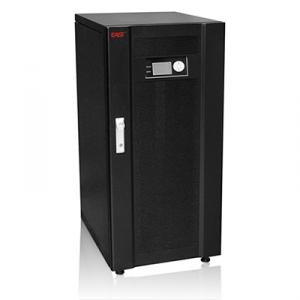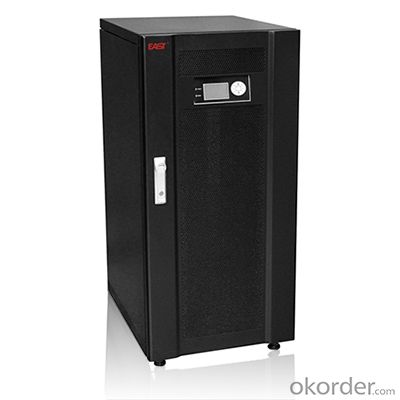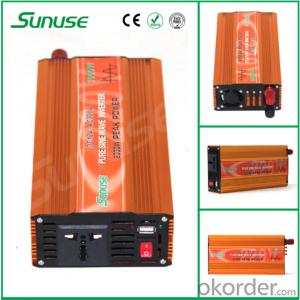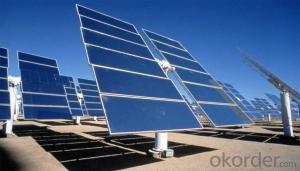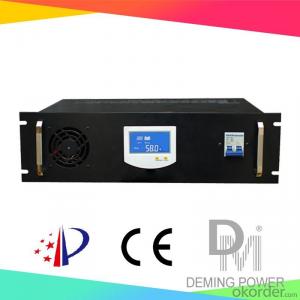High Power MPPT Solar Charge Controller Off-Grid Solar Power Systems with Solar Inverter 8kw
- Loading Port:
- China main port
- Payment Terms:
- TT or LC
- Min Order Qty:
- 1 pc
- Supply Capability:
- 1000 pc/month
OKorder Service Pledge
OKorder Financial Service
You Might Also Like
| High Power MPPT Solar Charge Controller |
GSC Series modular MPPT solar controller unit is a complete solar energy conversion, tracking, protection combined systems, this series product is developed depending on the needs of green power by EAST company. The solar energy collected by the PV panel is transferred into stable DC power output, advanced Maximum Power Point Tracking Technology (MPPT)and intelligent battery management system,intelligent monitoring system can be connected to PC by RS232/USB/RS485,remote monitoring by SNMP. Suitable for a variety of off-grid solar power systems. |
Efficient and stable,maximize the output power
● High power modular design,can parallel 8 pcs,maintenance is simple and fast, efficient and reliable system for easy expansion.
● High speed DSP the core control system and MPPT Maximum Power Point Tracking Technology,ensuring maximum output power of the system, improving the power generation efficiency of photovoltaic panels.
● Advanced multi-level control technology, switching losses smaller, more efficient.
● Professional cooling duct design, effectively discharge machine heat, to ensure stable operation of the controller
● Multiple input for the system, suitable for a variety of applications, roof, slope system.
Perfect protection design, safe and reliable
● Foolproof design is used in the system,ensure modules hot-swappable safety, providing safety operating for modules.
● PV input/output over/under voltage、PV reverse 、output anti-anti-irrigation、over temperature and other protections.
Smart battery management system
● Best charging mode can be used depending on battery type and capacity, to extend battery life.
● Over charging and over discharging protections.
Unattended and intelligent monitoring:
● After battery low voltage and automatically shut down, PV comes back,system will auto restart and charge the battery.
● RS232、USB and RS485 bus interface are available, real-time monitoring, testing can be done by communicating with PC,
SNMP(optional)net system is also available for remote real-time monitoring.
Model | GSC110-240 | GSC336-384 |
PV Input Range | 1-8 | |
Single Max Input Power | 0-500Vdc | 0-750Vdc |
Battery Numbers | 7KW-17KW | 24KW-27.5KW |
Max Charging Current | 55-120pcs can be set(2V per pcs) | 165-192pcs can be set(2V per pcs) |
Max Charging Current | 60A/120A/180A/240A/300A/360A/420A/480A | |
Equalizing Charging Voltage | (each one 2.4V)±1% | |
Float Charging Voltage | (each one 2.3V)±1% | |
Temperature Compensation | The voltage increases 2mV while temperature decrease 1℃ | |
Shared Parameters | ||
Max Efficiency | > 98% | |
Static Losses | < 5% (system rated current) | |
MPPT Accuracy | 0.99 | |
Dynamic Response | 25%-50%-25% or 50%-75%-50% load change 3ms | |
Display | LCD + LED | |
Cooling | Forced ventilation (fan speed changes with load) | |
Noise | ≤60dB | |
Protection | PV reverse、BUS over voltage、output over voltage、output reverse、 | |
PV over / under voltage | ||
Communication | RS232 / RS485 / SNMP card(optional) | |
IP Level | IP20 | |
Operating Temperature | From -20℃ to +45℃ | |
Humidity | 0-95% (non-condensing) | |
Storage Temperature | From -25℃ to +85℃ | |
Attitude | 1000m with rated power (increase 100m, reduce power 1%) Max.4000m | |
Dimensions (WxDxH mm) | 500x620x1050 | |
Packing Dimensions (WxDxH mm) | 585x710x1110 | |
Weight(kg) | Frame: 80kg ; MPPT power module: 5kg/unit | |
· Q. What is an UPS and What it is for ?
An uninterruptible power supply (UPS) is a device that allows your computer or telephone switch or critical equipement to keep running for at least a short time or longer time when the primary power source is lost. It also provides protection from power surges, spikes, brownouts, interference and other unwanted problems on the supported equipment.
· Q. How long the UPS to run when power goes?
This can take 3 paths.
1.You can pick a UPS that is rated for pretty much the full VA you need so it will be running at 100% of capability and will thus last 'n' minutes.
2.You can pick a UPS that is rated at a much higher VA value than you really need so, for example, is running at 50% of capability and will thus last for longer than the UPS from option 1.
3.You can use extra external battery packs to run for longer. If charging capability allows, the more and the bigger batteries you take with, the longer time UPS runs.
or using a generator after about 6 hours, it will be more cost-effective, with a short runtime UPS to bridge the generator start-up gap.
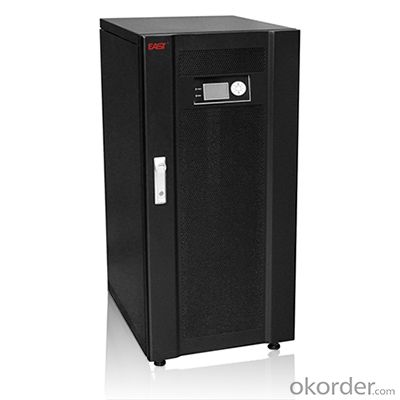
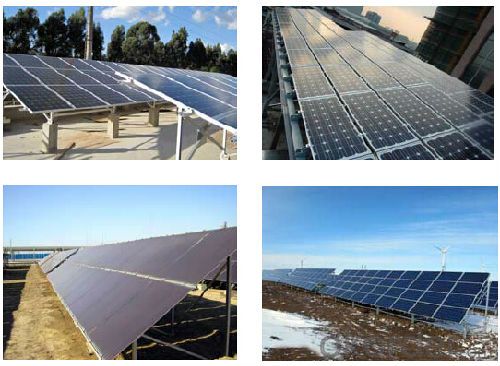
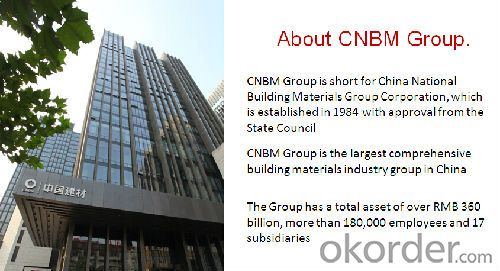

- Q: How do you choose the right size of solar inverter for a solar power system?
- To choose the right size of solar inverter for a solar power system, you need to consider the total capacity of your solar panels and the maximum power output they can generate. The solar inverter's capacity should be equal to or slightly higher than the maximum power output of your solar panels to ensure optimal performance and efficiency. Additionally, you should also consider any future expansion plans for your solar power system to account for potential increases in capacity. It is recommended to consult with a professional solar installer or engineer to accurately determine the appropriate size of the solar inverter for your specific requirements.
- Q: Can a solar inverter be used in systems with different module efficiencies?
- Yes, a solar inverter can be used in systems with different module efficiencies. Solar inverters are designed to convert the DC power generated by solar panels into AC power, regardless of the module efficiency. The inverter's main function is to optimize the power conversion process and ensure compatibility between the solar panels and the electrical grid. As a result, it can accommodate varying module efficiencies and still function efficiently.
- Q: Can a solar inverter be used with different grid voltages?
- No, a solar inverter cannot be used with different grid voltages. Solar inverters are designed to convert the DC power generated by solar panels into AC power that matches the voltage and frequency of the grid it is connected to. Using a solar inverter with different grid voltages can result in inefficient operation or even damage to the inverter. It is important to ensure that the solar inverter is compatible with the specific grid voltage before installation.
- Q: How does a solar inverter handle low light conditions?
- A solar inverter handles low light conditions by continuously monitoring the amount of sunlight received by the solar panels. When light levels drop, the inverter adjusts its operation to maximize power output by optimizing the voltage and current levels. It uses advanced algorithms and power electronics to convert the available sunlight into usable electricity efficiently, ensuring that even in low light conditions, the solar system continues to generate power.
- Q: How does a solar inverter handle voltage dips and swells?
- A solar inverter handles voltage dips and swells by constantly monitoring the incoming voltage from the solar panels and adjusting its output accordingly. When there is a dip in the grid voltage, the inverter compensates by injecting additional power into the system, whereas during voltage swells, it reduces its power output to prevent damage. This dynamic response ensures that the inverter maintains a stable and consistent voltage output, protecting both the solar system and the connected appliances.
- Q: Can a solar inverter be used in a mobile or portable solar power system?
- Yes, a solar inverter can be used in a mobile or portable solar power system. A solar inverter is responsible for converting the direct current (DC) generated by the solar panels into alternating current (AC) that can be used to power various devices. By incorporating a solar inverter into a mobile or portable solar power system, it becomes possible to harness solar energy and use it to power electronic devices while on the go. This makes it a convenient and sustainable option for providing electricity in remote locations or during outdoor activities.
- Q: Can a solar inverter be used with solar concentrators?
- Yes, a solar inverter can be used with solar concentrators. Solar concentrators focus sunlight onto a smaller area, increasing the intensity of the light. The solar inverter's primary function is to convert the DC power generated by the solar panels into AC power suitable for use in homes or businesses. Therefore, it can still be used to convert the enhanced DC power generated by solar concentrators into usable AC power.
- Q: Can a solar inverter be installed indoors or outdoors?
- A solar inverter can be installed both indoors and outdoors, depending on the specific requirements and preferences of the installation. However, it is essential to consider factors such as available space, ventilation, temperature regulation, and protection from environmental elements when deciding on the installation location.
- Q: Can a solar inverter be used with a hybrid solar system?
- Yes, a solar inverter can be used with a hybrid solar system. In fact, a solar inverter is an essential component of a hybrid solar system as it converts the DC power generated by the solar panels into AC power that can be used to power electrical devices or be fed into the grid. The inverter also allows for the seamless integration of other power sources, such as a battery storage system or a backup generator, in a hybrid solar system.
- Q: Can a solar inverter be used with a single solar panel?
- Yes, a solar inverter can be used with a single solar panel. The purpose of a solar inverter is to convert the direct current (DC) produced by the solar panel into alternating current (AC) that can be used to power electrical devices or be fed into the electrical grid. Even with a single solar panel, the inverter can still perform this function effectively.
Send your message to us
High Power MPPT Solar Charge Controller Off-Grid Solar Power Systems with Solar Inverter 8kw
- Loading Port:
- China main port
- Payment Terms:
- TT or LC
- Min Order Qty:
- 1 pc
- Supply Capability:
- 1000 pc/month
OKorder Service Pledge
OKorder Financial Service
Similar products
Hot products
Hot Searches
Related keywords
